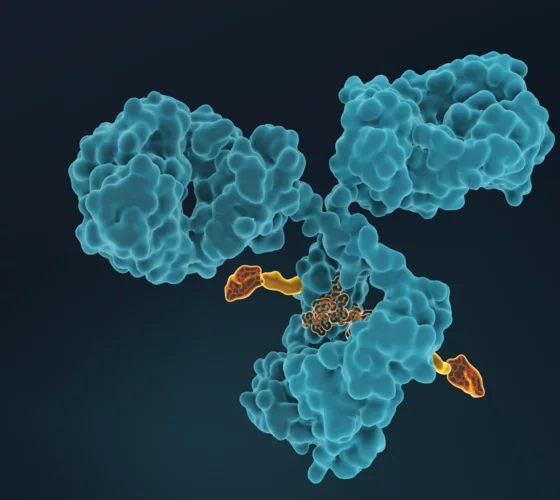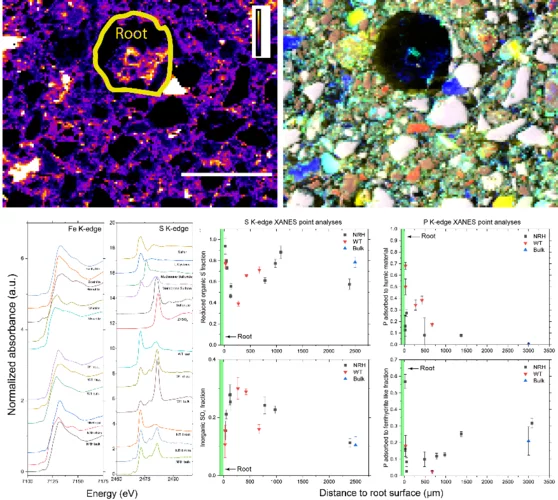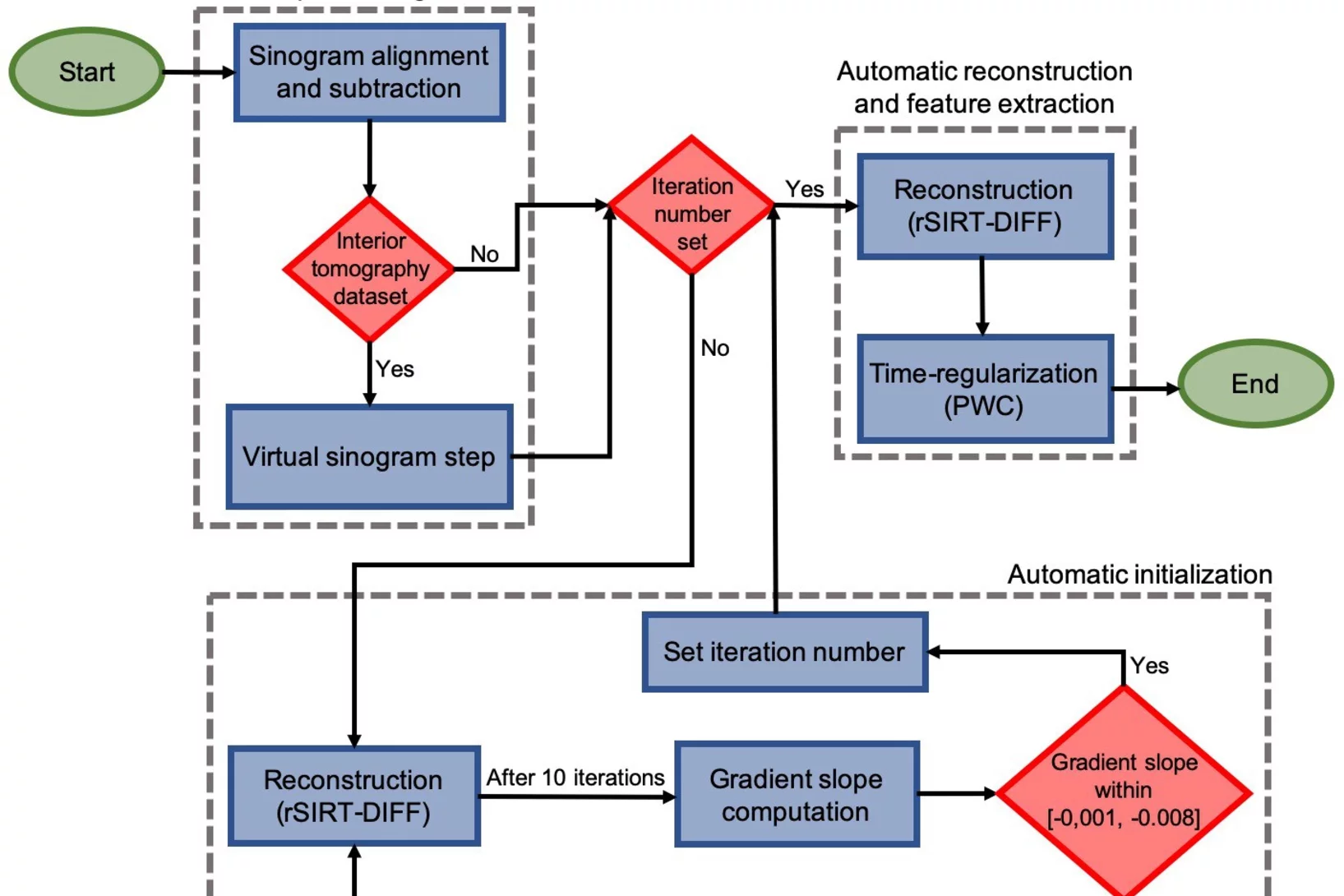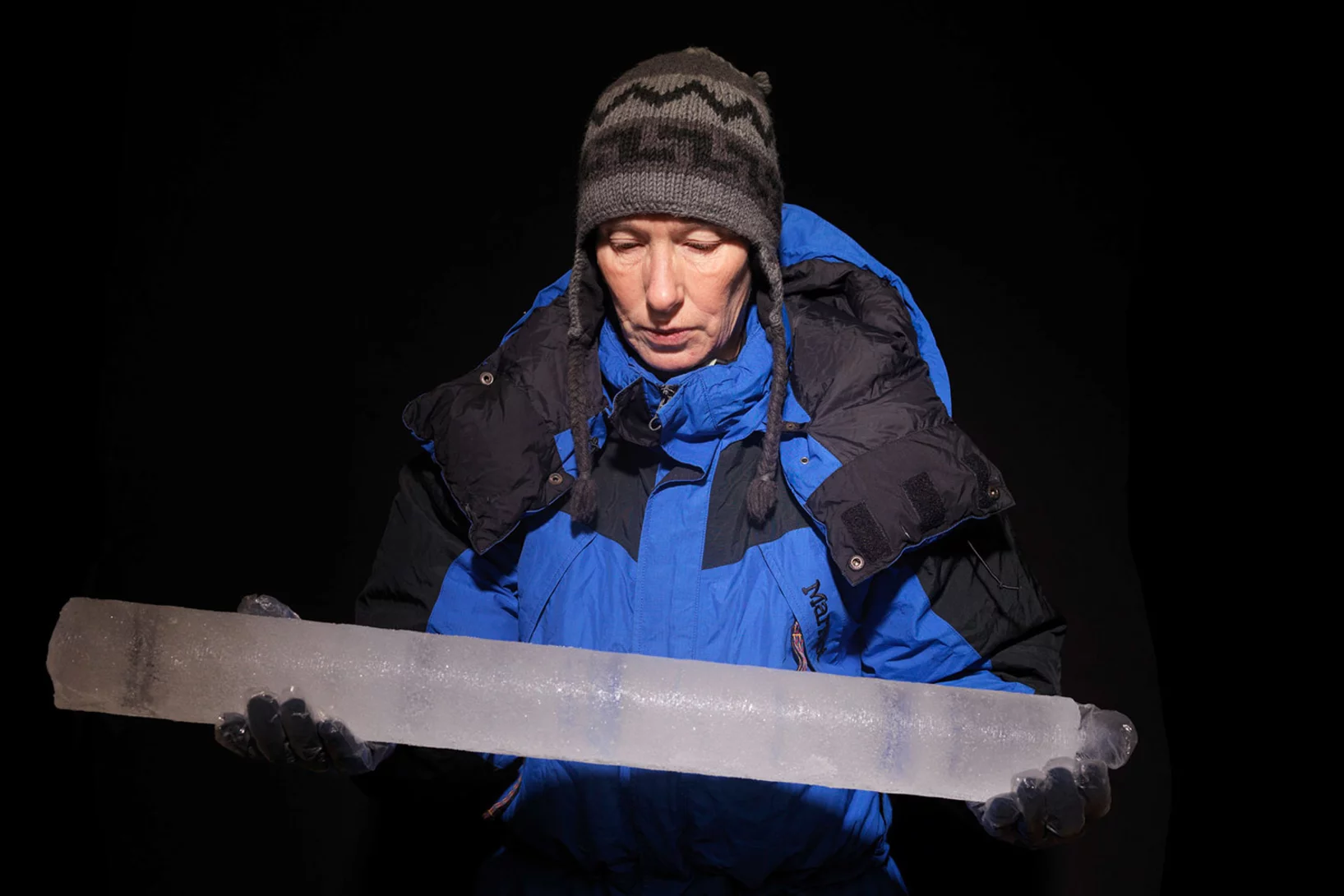Au PSI, plusieurs projets se consacrent à des questions de recherche importantes autour du coronavirus Sars-CoV-2 et des maladies qui en résultent. Nous vous informons sur les activités et les projets, par exemple sur les analyses de tissus pulmonaires, sur la production de protéines et d'anticorps ou sur les idées de nouvelles recherches sur le Covid-19.
Liens utils
Phosphorus recovery from wastewater: Nitrogen K-edge micro-XANES spectroscopy unravels the effects of nitrification inhibitor on fertilizer phosphorus uptake of maize
Phosphorous containing fertilizers are essential to feed the growing population on earth. Because phosphorus (P) is a scarce resource in the European Union, recovering P from wastewater and sewage sludge has become extremely important. However, the availability of P to the plant is limited in such recycling P fertilizers. To overcome this problem, co-fertilization with nitrogen (N) in the form of ammonium and nitrification inhibitors, is a promising pathway. By applying the novel N K-edge micro-XRF and micro-XANES methods at the PHOENIX beamline on the soils, we could verify that a nitrification inhibitor indeed promotes ammonium fixation in fertilized soils, and hence causing a slow-release of temporarily fixed ammonium. This deceases local pH, making P better available to plants.
Uncovering the short range order and local distortions in high entropy alloys using EXAFS
High entropy alloys (HEA), medium entropy alloys and multi-phase compositionally complex alloys (CCA) have gained much attention in the last 20 years because of their outstanding mechanical properties. Such baseless alloys provide different open questions on local chemical ordering, lattice distortions, orbital hybridization and/or charge transfer which define the very nature of alloys’ mechanical properties. By combining EXAFS measurements in the rarely served tender x-ray range (PHOENIX-SLS, Al K-edge) and at higher X-ray energies (BM08-ESRF, transition metal K-edges), local chemical ordering in a CCA, Al8Cr17Co17Cu8Fe17Ni33 was quantified showing preferred Al-Ni and Al-Cu pairs. In addition, slight structural distortions, much lower than the predicted ones of metallic radii, were found.
4 Lernende an den Schweizermeisterschaften
Die PSI-Elektroniker EFZ sind unter Strom
From magnetic order to quantum disorder in the Zn-barlowite series of S = 1/2 kagomé antiferromagnets
We report a comprehensive muon spectroscopy study of the Zn-barlowite series of S=1/2 kagomé antiferromagnets, ZnxCu4−x(OH)6FBr, for x = 0.00 to 0.99(1). By combining muon spin relaxation and rotation measurements with state-of-the-art density-functional theory muon-site calculations, we observe the formation of both μ–F and μ–OH complexes in Zn-barlowite. From these stopping sites, implanted muon spins reveal the suppression of long-range magnetic order into a possible quantum spin liquid state upon the increasing concentration of Zn-substitution.
SwissFEL: la mégachile des murailles s’y sent comme un poisson dans l’eau
En 2013, lors de la construction du SwissFEL, quelque cinq hectares de forêt ont été défrichés et réaménagés afin de servir de nouvel habitat pour la faune et la flore. Des biologistes et des ingénieurs forestiers viennent de tirer un bilan intermédiaire du succès de ce projet de renaturation. Et ils sont enthousiastes.
Araris Biotech AG annonce un tour de financement réussi
Araris, la plus récente spin-off du PSI dans le domaine des sciences de la vie, a mené à bien un tour de financement de 15,2 millions de francs suisses. Ces fonds constituent une excellente base pour poursuivre le développement des technologies licenciées par le PSI et pour identifier des candidats médicaments prometteurs.
Le Dr Philipp Spycher, PDG d'Araris Biotech AG, a commencé ses activités entrepreneuriales dans le cadre de la bourse de fondateur du PSI. Ce programme de bourse de fondateur du PSI l'a aidé à faire démarrer son idée d'entreprise en se basant sur la technologie qu'il a contribué à développer au PSI.
Le PSI félicite Araris et se réjouit d'accompagner son développement.
Front passivation of Cu(In,Ga)Se2 solar cells using Al2O3: Culprits and benefits
In the past years, the strategies used to break the Cu(In,Ga)Se2 (CIGS) light to power conversion effi- ciency world record value were based on improvements of the absorber optoelectronic and crystalline properties, mainly using complex post-deposition treatments. To reach even higher efficiency values, fur- ther advances in the solar cell architecture are needed, in particular, with respect to the CIGS interfaces. In this study, we evaluate the structural, morphological and optoelectronic impact of an Al2O3 layer as a potential front passivation layer on the CIGS properties, as well as an Al2O3 tunneling layer between CIGS and CdS.
Sodium-ion batteries: a study of the structural and electrochemical properties of the layered cathode material NaxMnyO2
Being able to replace Lithium by the much more abundant sodium for new batteries would be an important asset for energy storage. For example, NaxMnyO2 cathodes would offer a high initial specific charge and a relatively high working potential. Despite long, intensive research of the electrochemical properties of these materials, the open key question remains unresolved: Where does the sodium goes to in the charging /discharging process. Unfortunately, the (de)sodiation mechanism in those materials was not completely understood, especially in terms of types of phases in which Na stays during cycling, which in turn impeded the optimization of its performance. Using the unique tender energy range of the PHOENIX beamline, we used Na K-edge X-ray absorption spectra measurements to gain a better understanding about the Na atomic positions in phases appearing during cycling. Thanks to this unique method, we established that observed high capacity in NaxMnyO2 is due to the high-voltage phase being an intergrowth structure between P2 and O2 type phases were Na ions stays both in tetrahedral and octahedral sites.
Attendre et faire pousser des cristaux
Au PSI, les chercheurs décryptent la structure des protéines de bactéries et de virus. Ces connaissances permettent de développer des médicaments contre des maladies infectieuses. Mais tout d’abord il faut résoudre un problème épineux: la cristallisation de ces molécules.
Lithium-ion batteries: following the redox reaction of oxygen and transition metals in the Li1.2Mn0.6Ni0.1Co0.1O2 electrode using X-ray absorption spectroscopy
The new generation of cathode materials from the Li-rich NMC (nickel-manganese-cobalt) group are under constant investigation due to their extremely high energy densities resulting from redox reactions involving both transition metals and lattice oxygen. Although a lot of research has been done so far, the exact mechanism of lithium (de)insertion in those materials, especially the reactions involving redox reactions of lattice oxygen is still elusive. Due to the particular battery design the observed reactions starts at the surface of the electrode that contacts the electrolyte and, as the reaction continues, goes deeper into the bulk structure. In order to follow the reactions taking place in the Li-rich NMC materials we aimed to exactly distinguish and characterize the phase transitions taking place on the surface and within the bulk of the Li1.2Mn0.6Ni0.1Co0.1O2 electrode. To do so we used comprehensive XAS measurements at the PHOENIX beamline, taking advantage of the unique options to perform in situ experiments in the soft energy range to study both the Oxygen K edge and the L edges of Ni, Co and Mn.
Enhanced Stability of a Pyrophosphate cathode for Na-ion batteries
The structural changes of Na3.32Fe2.11Ca0.23(P2O7)2 during several charge discharge cycles is viewed by its powder pattern and selected cell parameter evolution.
Harnessing components from the optical internet for programmable spectroscopy
A novel concept for extracting information from spectra where traditional post-processing procedures fail, dubbed ‘software-defined spectroscopy’, offers a fresh approach to high-resolution terahertz spectroscopy. The new method implements an ‘optical comb’ and combines it with a programmable modulator, all using components from the optical internet.
Dr. Manuel Guizar-Sicairos elected as Fellow member of The Optical Society (OSA)
Dr. Manuel Guizar-Sicairos, beamline scientist at the cSAXS beamline, was elected as a Fellow Member of The Optical Society (OSA) for seminal contributions to methods and applications of coherent lensless imaging, ptychography, x-ray nanotomography, and new modalities of x-ray microscopy.
Root induced soil deformation influences Fe, S and P: rhizosphere chemistry investigated using synchrotron XRF and XANES
Taking up nutrients from the soil is key to plant growth. Understanding and potentially controlling this process is important when growing food but also when caring for natural habitats, which are the basis for life on Earth. Typically, nutrients are tightly chemically bound to the soil, and roots need to create a chemical environment to harvest nutrients. Here we use the special capabilities X-ray microscopy with tender X-rays to study the chemical changes of sulfur, phosphorus, and iron in the vicinity of plant roots (rhizosphere). We can show that Fe is slightly reduced, S is increasingly transformed into sulfate (SO42−) and phosphorus (P) is increasingly adsorbed to humic substances in this enrichment zone around the root.
Demonstration of Muon-Beam Transverse Phase-Space Compression
We demonstrate efficient transverse compression of a 12.5 MeV=c muon beam stopped in a helium gas target featuring a vertical density gradient and crossed electric and magnetic fields. The muon stop distribution extending vertically over 14 mm was reduced to a 0.25 mm size (rms) within 3.5 μs. The simulation including cross sections ...
Déformation inattendue d’une protéine
Des chercheurs du PSI ont découvert un secret du cytochrome c, que cette protéine vitale avait bien gardé jusque-là. Des mesures au laser à rayons X à électrons libres SwissFEL ont mis en évidence des modifications structurelles que la science avait pourtant exclues pour ce type de biomolécules.
Refined diagnosis of the “concrete disease”
When bridges, dam walls and other structures made of concrete (cement and aggregates such as sand/gravel) are marked by map-like cracks after a few decades, the diagnosis is ASR (alkali-silica Reaction), in popular science terms also called “concrete disease or concrete cancer”. The ASR-induced microscale crack initiation can hardly be modelled, mainly due to our limited knowledge of the structure and property of the ASR products. Using X-ray absorption micro-spectroscopy at the PHOENIX beamline of the Swiss Light Source (SLS) allowed a refined diagnosis of ASR products by providing new insights into the crystallinity and structure of ASR products with micro-scale resolution.
Installation of Heidelberg DWL66+
Heidelberg DWL66+ direct laser writer, funded by ANAXAM, is in operation now. It is a new photolithographic system closing the gap between the mask aligners on one side and the Nanoscribe two-photon 3D lithography system on the other. It is equipped with semiconductor laser with the wave length of 405 nm and is capable of exposing the minimum feature size down to 0.3 µm on wafers up to 200 mm or 9"x9" mask blanks.
Des mesures au PSI ont permis une compréhension précise des ciseaux génétiques
Le PSI félicite Emmanuelle Charpentier et Jennifer Doudna, lauréates 2020 du Prix Nobel de chimie. Des expériences menées en 2013 à la Source de Lumière Suisse SLS ont permis d’élucider la structure du complexe protéique CRISPR-Cas9.
Improved Interfacial Stability of Ni-rich Oxide Full-Cells
PSI researchers have identified a novel electrolyte additive, allowing extended voltage range of Ni-rich oxide full-cells, while keeping excellent performance. The instability of cathode–electrolyte interface causes the structural degradation of cathode active material and the electrolyte consumption, resulting in a rapid capacity fading and shortening battery life-time. The PSI-identified additive help to alleviate these problems and extend battery life-time.
Electroless Deposition of Ni–Fe Alloys on Scaffolds for 3D Nanomagnetism
3D magnetic nanostructures are of great interest due to the possibility to design novel properties and the benefits for both technological applications such as high-density data storage, as well as more fundamental studies.
One of the main challenges facing the realization of these three-dimensional systems is their fabrication, which includes the deposition of magnetic materials on 3D surfaces. In this work, the electroless deposition of Ni–Fe
on a 3D-printed, non-conductive microstructure is presented.
Technology Briefing: Smart Energy Applied Solutions
Mittwoch, 11.November 2020, 13.30 – 18.00 Uhr
Empa, Überlandstrasse 129, 8600 Dübendorf (Participation possible sur place OU via Zoom)
Online-Inscription: www.empa-akademie.ch/technology
Le "Technology Briefing" vise à informer l'industrie et le commerce sur les questions d'actualité relatives aux pratiques. Des orateurs du CSEM, de l'Empa et du PSI ainsi que de l'industrie donneront un aperçu équilibré et orienté vers la pratique des technologies actuelles. En plus de fournir des informations, l'événement permet également d'échanger des expériences avec des experts et d'identifier des potentiels de coopération et d'innovation.
Combattre le cancer de la thyroïde de manière plus ciblée
Des chercheurs du PSI ont découvert comment traiter un type de cancer de la thyroïde de manière plus ciblée avec moins d’effets indésirables. Ils ont augmenté l’absorption de la substance antitumorale dans les cellules cancéreuses. Leurs résultats paraissaient dans la revue Theranostics.
Automatic extraction of dynamic features from sub-second tomographic microscopy data
A fully automatized iterative reconstruction pipeline designed to reconstruct and segment dynamic processes within a static matrix has been developed at TOMCAT. The algorithm performance is demonstrated on dynamic fuel cell data where it enabled automatic extraction of liquid water dynamics from sub-second tomographic microscopy data. The work is published in Scientific Reports on 2 October 2020.
Automatic extraction of dynamic features from sub-second tomographic microscopy data
A fully automatized iterative reconstruction pipeline designed to reconstruct and segment dynamic processes within a static matrix has been developed at TOMCAT. The algorithm performance is demonstrated on dynamic fuel cell data where it enabled automatic extraction of liquid water dynamics from sub-second tomographic microscopy data. The work is published in Scientific Reports on 2 October 2020.
L’acide iodique impliqué dans la formation de nuages en Arctique
Une équipe de recherche internationale a identifié un nouveau facteur qui favorise la formation de particules de poussières fines dans l'Arctique. Il s'agit de l'acide iodique, un composé chimique qui n'a jamais été mesuré dans la région auparavant.
«Nous avons été choqués de découvrir à quel point déjà la fonte était avancée»
Au Grand Combin (VS), à plus de 4000 mètres d’altitude, une expédition internationale avec participation de l’Institut Paul Scherrer (PSI) a découvert que la fonte du glacier était très avancée. Pour le projet Ice Memory, qui vise à prélever des carottes de glace pour constituer une archive climatique destinée aux futures générations de chercheurs, cela signifie que dans les Alpes, il pourrait bien être trop tard.
Swiss National Science Foundation Ambizione grant for Franziska Hagelstein
Franziska Hagelstein has been awarded a Swiss National Science Foundation Ambizione grant with PSI as host institution. She joined the particle theory group (NUM, Laboratory of Particle Physics LTP) in October 2020. In the near future she will be accompanied by a PhD student.
L’infiniment petit mis en lumière
L’univers des microbes et des virus est extrêmement ancien et diversifié. À l’aide des grandes installations du PSI, les chercheurs scrutent en profondeur ce cosmos inconnu et explorent surtout les protéines de ces êtres exotiques.
Two-color snapshots of ultrafast charge and spin dynamics
In a joint research effort, an international team of scientists lead by Emmanuelle Jal (Sorbonne Université) performed a time-resolved experiment at the FERMI free-electron laser to disclose the dynamic behavior of two magnetic element of a compount material in only one snapshot. The X-ray Optics and Applications group developed a dedicated optical element for this experiment that is usable with two different photon energies (colors) simultaneously.





























